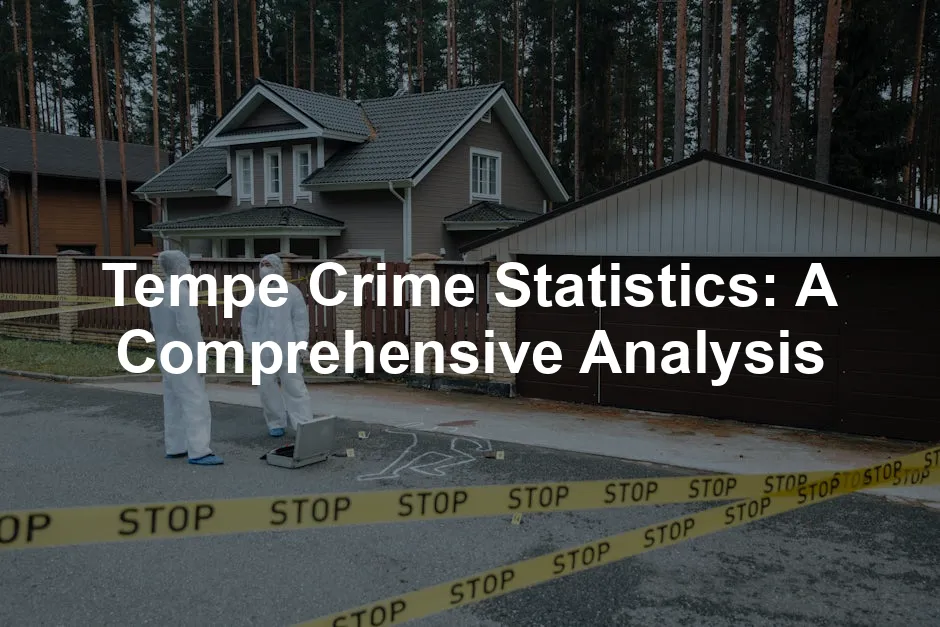Introduction
Welcome to Tempe, Arizona! Nestled in the heart of Maricopa County, Tempe is a vibrant city known for its cultural richness and educational opportunities, primarily due to Arizona State University (ASU). With a population of over 180,000, Tempe boasts a melting pot of diverse residents, contributing to a lively community filled with events, festivals, and outdoor activities. From stunning parks to bustling nightlife, it’s a place many call home.
Understanding crime statistics is crucial for several reasons. For residents, it means staying informed about safety in their neighborhoods. For potential movers, crime rates can influence decisions on where to settle down. Local authorities rely on this data to allocate resources effectively and enhance community safety. Knowledge is power, and in the case of crime, it can be a lifeline.
This article aims to provide a thorough analysis of crime statistics in Tempe. We will compare local rates with state and national averages, offering insights into the implications for community safety. By understanding these statistics, residents and stakeholders can work together to create a safer environment for everyone. Whether you’re a long-time resident or considering a move, this information will be essential in navigating Tempe’s crime landscape.

Understanding Tempe’s Crime Landscape
Overview of Crime Statistics in Tempe
Tempe has a crime rate of 52 per 1,000 residents, which is notably high. This figure indicates that the likelihood of becoming a victim of crime is one in 19, a statistic that raises eyebrows. When we analyze crime statistics, it’s important to understand how these numbers are calculated. Crime rates are typically measured based on reported incidents per population size, allowing for comparisons across different locations.
A high crime index can be alarming, but it’s essential to consider the context behind the numbers. Factors such as population density, socioeconomic conditions, and law enforcement practices can all influence crime rates. In Tempe, the mix of a large student population and urban development adds unique challenges to crime prevention efforts.
To secure your home and give yourself peace of mind, consider investing in a Home Security Camera System. With advanced features like motion detection and cloud storage, you can monitor your property anytime, anywhere. It’s like having a personal security guard, but without the hefty salary!

Types of Crimes in Tempe
Violent Crimes
In Tempe, the violent crime rate stands at 5.96 per 1,000 residents. Breaking this down further, the statistics reveal the following incidents: 7 murders, 159 rapes, 180 robberies, and 763 assaults. These figures paint a stark picture, especially when compared to the national average of 4 per 1,000 residents. Tempe’s rates indicate a need for ongoing community vigilance and proactive measures to enhance safety.
Property Crimes
On the property crime front, Tempe faces a rate of 45.71 per 1,000 residents. This includes 948 burglaries, 6,749 thefts, and 803 motor vehicle thefts. When juxtaposed with the national average of 20 property crimes per 1,000 residents, it becomes clear that Tempe grapples with significant property crime challenges. Residents must stay informed and engaged to mitigate these risks.
If you’re looking for an easy way to enhance your personal safety, consider carrying a Personal Safety Alarm. It can be a lifesaver in emergencies, emitting a loud noise to attract attention and scare off potential threats. Better safe than sorry, right?

As we delve into Tempe’s crime statistics, it’s evident that awareness and understanding are key components in addressing safety concerns. By educating ourselves on these issues, we can better navigate our community and work towards a safer Tempe for all.
Crime Rate Comparison
Tempe vs. National Crime Statistics
When it comes to crime rates, Tempe is making headlines for all the wrong reasons. With a crime rate of 52 per 1,000 residents, Tempe stands out as one of the highest in the nation. This number is not just a small bump; it’s a significant leap above both the national average and the state average. The national violent crime rate sits at about 4 per 1,000 residents, while Tempe’s violent crime rate is nearly 6 per 1,000 residents. Property crime in Tempe is also a major concern, clocking in at 45.71 per 1,000 residents, compared to the national average of just 20 per 1,000.
This comparison shows that Tempe’s crime rates are significantly higher than both the national and state averages. In fact, over 97% of communities in Arizona report lower crime rates than Tempe. It’s like being the tallest kid in a room full of shorties, and that’s not a title anyone wants to claim. With such alarming statistics, residents must stay informed and proactive about their safety.

Crime Rates Over Time
Now, let’s take a journey through time—without the DeLorean, of course! Comparing crime rates from 2010 to 2022 reveals some eye-opening trends. In 2010, Tempe experienced a total crime rate of around 4,897 incidents per 100,000 people. Fast forward to 2022, and this number has surged to about 9,221 incidents. That’s an increase of over 112%!
Violent crime rates have fluctuated, with some years showing decreases, but the overall trend indicates a worrying rise. For example, while the number of murders remained relatively stable, other violent crimes like assaults have crept up significantly. Property crimes tell a similar story, with thefts and burglaries continuing to rise. This long-term view highlights a pressing need for effective crime prevention measures.

Neighborhood-Specific Crime Analysis
Safer Neighborhoods
On the brighter side, not all neighborhoods in Tempe are crime hotspots. Areas like Arizona State University and Warner Estates are known for their lower crime rates. The student population at ASU contributes to a vibrant community where residents often look out for one another. In Warner Estates, community initiatives and active neighborhood watch programs have helped keep crime at bay. Statistics reveal that these neighborhoods boast significantly lower crime rates compared to the city average, making them appealing for families and students alike.
Understanding the role of community initiatives in crime prevention is vital. fst statistic measures examples can provide insight into how statistics are used to assess community safety.
Higher Crime Areas
Conversely, some neighborhoods are struggling. Areas like Alegre Community and Escalante have higher crime rates, raising alarms among residents. Factors such as socio-economic challenges, limited access to resources, and inadequate law enforcement presence contribute to crime in these neighborhoods. For instance, Alegre Community has seen a spike in property crimes, with thefts and burglaries becoming common. Escalante faces similar issues, with community members often expressing concern about safety. Understanding these dynamics is essential for residents who wish to stay informed and safe in their communities.
In conclusion, while Tempe has its challenges concerning crime rates, awareness and community engagement can play pivotal roles in fostering a safer environment. By knowing the statistics and understanding neighborhood dynamics, residents can take proactive steps to protect themselves and their communities.

Factors Influencing Crime Rates
Economic Factors
Economic conditions play a significant role in shaping crime rates. In Tempe, high unemployment and poverty levels correlate with increased crime. When people struggle to make ends meet, some may resort to crime as a means of survival. It’s a harsh reality, but economic strain often leads to desperation.
Rising living costs can add fuel to this fire. As rent and basic necessities soar, individuals may feel pushed into criminal behavior. For instance, theft and burglary rates could rise when people feel financially squeezed. It’s a troubling cycle: financial stress breeds crime, which in turn can lead to more stringent law enforcement actions and community fear.
Additionally, Tempe’s student population adds a unique twist to the economic landscape. Many students juggle tuition costs and living expenses, which may influence their involvement in petty crimes. Understanding this economic backdrop is crucial for tackling crime effectively and addressing its root causes.

Law Enforcement Presence
Tempe’s law enforcement presence is an essential factor in crime prevention. Currently, there are about 2.8 law enforcement officers for every 1,000 residents. This number is slightly lower than the national average, which stands at 3.3 officers per 1,000 residents. Consequently, fewer officers may mean less community engagement and slower response times.
However, quality often trumps quantity. Tempe’s police department emphasizes community policing and proactive engagement. Officers are visible and actively participate in community events, fostering trust and cooperation between law enforcement and residents. This connection can be a game-changer in crime prevention. When residents feel comfortable reporting suspicious activities, it aids in nipping crime in the bud.
Moreover, ongoing training for officers and community outreach programs help improve the effectiveness of policing efforts. The presence of law enforcement can deter potential criminals, creating a safer environment for everyone.

Community Initiatives
Local initiatives play a pivotal role in curbing crime rates in Tempe. Community watch programs are at the forefront of these efforts. Residents band together to keep an eye on their neighborhoods, reporting suspicious activities to the authorities. This collective vigilance helps build a sense of safety and camaraderie among residents.
Youth engagement programs also shine in Tempe. By providing constructive activities for young people, such as sports, arts, and after-school programs, the community reduces the likelihood of youth falling into criminal behavior. When kids have positive outlets, they’re less likely to engage in crime.
Furthermore, educational initiatives that teach residents about safety and crime prevention strategies empower the community. Workshops on home security and personal safety are instrumental in equipping residents with the knowledge they need to protect themselves. For instance, a Smart Door Lock can enhance your home security and give you peace of mind. Say goodbye to fumbling for keys!
In summary, the interplay of economic factors, law enforcement presence, and community initiatives significantly shapes crime rates in Tempe. By addressing these areas, the city can work towards reducing crime and fostering a safer environment for all its residents.

Safety Assessment and Community Perception
Survey Results
A recent survey has shed light on how residents perceive safety in Tempe. Among the participants, 70% reported feeling “pretty safe,” acknowledging some concerns but overall feeling secure in their neighborhoods. Surprisingly, 18% felt “very safe,” with no safety worries at all. However, a notable 12% admitted to feeling “somewhat safe,” signaling that safety issues linger in the community.
When it comes to law enforcement effectiveness, opinions vary. About 58% of respondents believe that police are “very visible and very responsive.” This suggests a positive relationship between the community and the police force. Yet, 18% feel that while the police are visible, their response times could improve. Another 15% are unsure, which indicates a lack of confidence in law enforcement’s presence. The remaining 9% expressed that police may not be around much but respond quickly when needed. These mixed feelings highlight the community’s complex relationship with safety and law enforcement.

Public Safety Measures
Local authorities are not sitting idle regarding safety concerns. They’ve implemented several measures to enhance public safety. Increased police patrols are a primary strategy to deter crime. Officers are more visible at critical times, creating a sense of security for residents.
In addition to patrols, Tempe has launched community programs aimed at fostering safety. Neighborhood watch groups are gaining traction, empowering residents to take an active role in their community’s safety. These groups encourage neighbors to look out for each other, report suspicious activities, and build a sense of unity. If you’re looking to make your home safer, consider a Smoke and Carbon Monoxide Detector. It’s a small investment for your safety!
Moreover, local authorities are focusing on youth engagement initiatives. By providing constructive activities and educational programs, they aim to steer young people away from crime. These efforts are crucial in addressing the root causes of crime and creating a safer environment for everyone.
In conclusion, the blend of community perception and proactive public safety measures paints a picture of a city striving to improve its safety record. While some residents feel secure, others express valid concerns. By continuing to engage the community and implement effective strategies, Tempe is on a path toward enhanced safety for all its residents.

Conclusion
In summary, Tempe’s crime statistics paint a concerning picture. With a crime rate of 52 per 1,000 residents, it’s one of the highest in the nation. The violent crime rate of 5.96 per 1,000 residents surpasses the national average. Property crime is even more alarming, with a staggering 45.71 per 1,000 residents. These figures reveal that the odds of becoming a victim of crime are all too real, making community engagement and awareness essential for personal safety.
Understanding these statistics is vital. It empowers residents to take precautionary measures and remain vigilant. Knowledge of crime trends allows individuals to make informed decisions about their safety and well-being. This data isn’t just numbers; it’s a call to action for everyone living in Tempe. Each resident should engage with local law enforcement, participate in neighborhood watch programs, and contribute to community safety initiatives.
Moreover, policymakers play a crucial role. They must prioritize resources toward crime prevention and community engagement efforts. By investing in social programs, improving economic conditions, and fostering positive interactions between law enforcement and residents, the city can create a safer environment. It’s about building trust and collaboration.
Together, residents and officials can work toward reducing crime and enhancing safety. Community engagement is the key. So, let’s roll up our sleeves, get involved, and create a safer Tempe for everyone. After all, a united community is a stronger community, and together we can tackle the challenges that lie ahead.

FAQs
What are the common types of crime in Tempe?
In Tempe, the most common types of crime include property crimes like theft, burglary, and motor vehicle theft. Violent crimes, though less frequent, still pose serious concerns, with assault, robbery, and sexual offenses being reported. The numbers indicate that residents should remain vigilant and informed about safety measures in their neighborhoods.
How does Tempe’s crime rate compare to nearby cities?
Tempe’s crime rate is significantly higher than many neighboring cities. For instance, Chandler has a crime rate of 150 per 100,000 residents, and Gilbert is even lower at 88.4 per 100,000. In contrast, Tempe’s rate of 388.1 puts it among the highest, making it essential for residents to stay aware and proactive about their safety.
What should residents do to stay safe in Tempe?
To stay safe in Tempe, residents should take several precautions. First, remain aware of your surroundings, especially in less populated areas. Joining neighborhood watch programs can also foster community vigilance. Additionally, securing homes with quality locks and alarms is advisable. Finally, participating in local safety workshops and engaging with law enforcement can provide valuable safety tips and build community trust.
Please let us know what you think about our content by leaving a comment down below!
Thank you for reading till here 🙂
All images from Pexels




